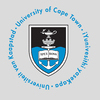Disaster mitigation initiatives come to the fore
03 March 2003
Risk reduction: Students recently completed the DiMP Disasters and Development short course in Cape Town. Photographed at the certificate presentation were DiMP staff (from left) Sylvia Prime, Nazley Galant, Leigh Sonn, Helen McGregor, Dr Ailsa Holloway and Gillian Fortune.
THE DISASTER Management Act of South Africa, promulgated on January 15 this year, will go a long way to reducing the vulnerability of communities and households in at-risk areas, whether due to fire, flooding or other disasters, says Dr Ailsa Holloway, co-ordinator of UCT's Disaster Mitigation Unit (DiMP).
“The new Act is regarded as path-breaking legislation, not only for South Africa but also world-wide,†she explained.
Holloway said that the impetus for the new legislation came in the aftermath of the 1994 Cape Flats floods, which severely affected residents in informal settlements on the periphery of Cape Town. It reflects more than seven years of collaboration between a wide range of professional, academic and non-governmental partners.
DiMP was closely involved in the development of the legislation, contributing to the Green and White Papers on disaster management and advising the Parliamentary Portfolio Committee in its deliberations of the Disaster Management Bill.
Natural forces alone are not always to blame for disasters. According to Holloway there is growing consensus that disasters occur as a result of natural and human induced processes, with human action primarily responsible for transforming “natural hazards†into “unnatural disastersâ€.
Since the 1994 floods, repeated disasters have underlined the contribution that poor development practice makes to disaster risk, especially in impoverished urban and rural communities, Holloway added. “Mitigating refers to proactive measures to reduce the likelihood of disasters, and this is most effectively achieved through development interventions.â€
The Unit has several international links and also works in partnership with local institutions, such as the Cape Metropolitan Council (Disaster Management). Its primary research initiative is the MANDISA project (Monitoring, Mapping and Analysis of Disaster Incidents in South Africa), a computerised database of disaster incidents linked to a geographic information system, used to facilitate strategic development planning.
On the education and training front, the Unit offers a range of resources and courses, both for practitioners in the area of disaster risk and students, with undergraduate and honours courses in this area of study. News on this front is that a two-year MSc programme will be launched soon on Disaster Risk Science, in collaboration with the Department of Environmental and Geographical Science.
“This is the first academic programme of its kind in the country,†Holloway added. “Our aim is to produce multi-skilled professionals able to work in a wide range of settings and with applied specialisation options that include food and livelihood security, applied climate science and links with public health and urban planning.â€
DiMP's contribution to training includes the Disasters and Development programme, a two-week, bi-annual course offered by the Disaster Mitigation for Sustainable Livelihoods Programme. Thus far 150 participants from across the country have received their colours.
“We teach that responsibility in reducing disasters is a shared undertaking that goes far beyond improved disaster or emergency response,†Holloway noted. “It gives explicit priority to assessing and building on household and community capabilities in at-risk communities.â€
 This work is licensed under a Creative Commons Attribution-NoDerivatives 4.0 International License.
This work is licensed under a Creative Commons Attribution-NoDerivatives 4.0 International License.
Please view the republishing articles page for more information.
Monday Monthly
Volume 22 Edition 03
03 Mar 2003
News
Previous Editions

Volume 22 Edition 02
24 Feb 2003

Volume 22 Edition 01
14 Feb 2003

Volume 21 Edition 38
09 Dec 2002

Volume 21 Edition 37
02 Dec 2002






